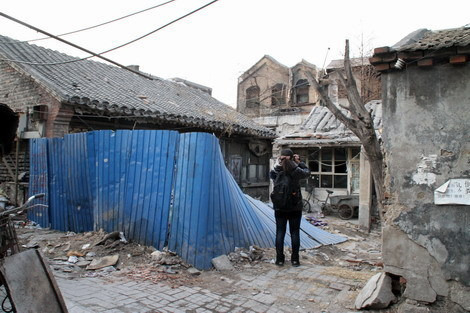
The former home of Kang Youwei (1825-1927) in Beijing's Xuanwu District. Kang was a pro-reformist scholar, thinker and artist who advocated constitutional monarchy during the late Qing Dynasty (1644-1911) period. Kang's other home in Shanghai, a 210 squar
An apartment labeled as the former residence of a famous Chinese calligrapher and ideologue has sparked controversy over the cultural value of property in Shanghai, amid a slowdown in the real estate sector.
The 210 square meter apartment, priced at 9.5 million yuan (US$1.5 million) or about 45,240 yuan per square meter, is said to be the former home of Kang Youwei (1825-1927), a pro-reformist scholar, thinker and artist who advocated constitutional monarchy during the late Qing dynasty (1644-1911) period.
Another 28 square meter property in the same compound, Zhonghua Xincun, which was renovated in 1936, was priced at 600,000 yuan, or 27,000 yuan per square meter. The average price of the compound was about 27,077 yuan per square meter in March, but rocketed to 36,920 yuan per square meter in April, a 36.35 percent month-on-month increase, according to online property trading platform Anjuke.com.
Xie Feiyu, an agent with Xinyou Real Estate Agency in Jing'an district, said the Kang apartment pushed up the average price of the compound.
"Old homes of past celebrities are a rarity in Shanghai and investment in such apartments may bring considerable profits in the long run," Xie said.
Since the Kang apartment was included in Xie's list of offerings in late March, more than 10 people have made inquiries but not a single one has looked at the apartment, the agent said.
"Buyers are quite price sensitive. In their eyes the price might be too high and they might wait for a lower quote," Xie said.
The initial quote for Kang's apartment was 10 million yuan in late March, Xie said.
While property agents claimed that the apartment—located in Jing'an district where Kang turned from a keen social activist to a hermit hidden in a busy city—and the four magnolia trees in the garden were linked to Kang himself, cultural heritage authorities of the district said that was not the case.
Kang did rent a house in the current Zhonghua Xincun, but the compound has been renovated and transformed and is not the original site of Kang's residence, Yang Jiguang, head of the research institute of culture and history of Jing'an district, was quoted by the Jiefang Daily as saying.
Labeling the property as Kang's former residence can only be a sales pitch, the Jiefang Daily quoted Yang as saying.
The trading of such old houses has become popular in the real estate sector since the late 1990s, said Jin Gongquan, a real estate agent who has been working in Shanghai for 12 years.
Artists and designers from all over the world would love to rent or buy former residences of past celebrities to use as their studios if the ownership of the homes is clear, Jin said.
Some business people are also interested in turning an old house into a restaurant, pub, or gallery, as they believe real estate with history may bring a touch of nostalgia, Jin said.
But not everyone agrees that these former residences are appealing.
Xu Cuilan, a 52-year-old shopkeeper and Shanghai native, lives in a room of an old house at Chongqing Road. The building is a former French residential block built for a few households that have been split into smaller rooms for more than 20 households today.
In Shanghai, there are more than 20 such houses downtown, with plates issued by the local government stating that the building is a heritage site and should be protected accordingly.
Xu says she has mixed feelings about the European-style buildings.
"The location is prestigious and the house is definitely stylish if you look from the outside, but the facilities are not good - we don't have clean bathrooms and the space is so limited," Xu said.
Many of such European-style houses were built during the concession period from the mid-19th century to mid-20th century, with interior heights of at least four-meters, baroque exteriors and outstanding construction quality that has survived more than a century.
"When you consider that it was once used for a couple of households and is now turned into a bunch of pigeon-hole units, you'd understand we can't wait to be relocated," Xu said.
But ownership issues mean relocation from the block is not easy.
"Some houses have endured various periods in history and witnessed numerous owners, and some very beautifully built houses which can perfectly cater to people's needs nowadays are not used properly due to complicated ownership issues," said Jin, the property agent.

Copyright ©1999-2011 Chinanews.com. All rights reserved.
Reproduction in whole or in part without permission is prohibited.